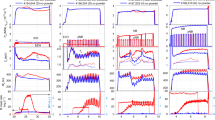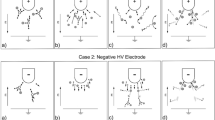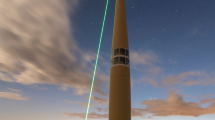Abstract
Intense electrical discharges through polymer fibres have been shown1 to produce 2.45-MeV neutrons, probably by deuteron–deuteron fusion. Noting broad similarities between discharges in polymer fibres and natural lightning, Libby and Leukens2 have suggested that neutrons are also generated in lightning flashes, as a result of the fusion of deuterium contained in the atmospheric water vapour; by rescaling the plasma parameters of polymer fibres to those involved in natural lightning, they have predicted a yield of ∼1015 neutrons per lightning flash. An experiment by Fleischer3, however, using fission track detectors placed near lightning arrestors, has failed to ascertain the neutron production in lightning discharges. Based on the number of background cosmic-ray tracks accumulated in these detectors during seven months of observations, Fleischer estimated an upper limit of 2.5×1010 neutrons per lightning stroke. In our experiment, we have attempted to keep the cosmic-ray neutron background at a negligible level by searching for neutrons from individual lightning strokes, for a time-interval comparable with the duration of the lightning stroke. Here we present the first experimental evidence that neutrons are generated in lightning discharges, with 107–1010 neutrons per stroke. Whether these neutrons are thermonuclear in origin, or are generated by non-thermal processes, remains to be determined.
This is a preview of subscription content, access via your institution
Access options
Subscribe to this journal
Receive 51 print issues and online access
$199.00 per year
only $3.90 per issue
Buy this article
- Purchase on Springer Link
- Instant access to full article PDF
Prices may be subject to local taxes which are calculated during checkout
Similar content being viewed by others
References
Stephanakis, S. J., Levine, L. S., Mosher, D., Vitkovitsky, I. M. & Young, F. Phys. Rev. Lett. 29, 568–569 (1972).
Libby, L. M. & Lukens, H. R. J. geophys. Res. 78, 5902–5903 (1973).
Fleischer, R. L. J. geophys. Res. 80, 5005–5009 (1975).
Sdobnov, V. E., Krestyannikov, Yu Ya., Sergeev, A. V. & Tergeov, V. I. 17th Int. Cosmic Ray Conf. 4, 338–341 (1981).
Aleksanyan, T. M., Blokh, Ya. L., Dorman, L. I. & Starkov, F. A. 16th Int. Cosmic Ray Conf. 4, 321–324 (1979).
Uman, M. A. Proc. IEEE 59, 457–462 (1971).
Newkrik, L. L. J. geophys. Res. 68, 1825–1833 (1963).
Young, F. C., Stephanakis, S. J., Vitkovitsky, I. M. & Mosher, D. IEEE Trans. Nucl. Sci. 20, 439–445 (1973).
Libby, L. M. & Leukens, H. R. J. geophys. Res. 80, 3506 (1975).
Author information
Authors and Affiliations
Rights and permissions
About this article
Cite this article
Shah, G., Razdan, H., Bhat, C. et al. Neutron generation in lightning bolts. Nature 313, 773–775 (1985). https://doi.org/10.1038/313773a0
Received:
Accepted:
Issue Date:
DOI: https://doi.org/10.1038/313773a0
This article is cited by
-
Significant enhancements of secondary cosmic rays and electric field at the high mountain peak of Lomnický Štít in High Tatras during thunderstorms
Earth, Planets and Space (2020)
-
Ten years of AGILE: the mission and scientific highlights
Rendiconti Lincei. Scienze Fisiche e Naturali (2019)
-
Photonuclear reactions triggered by lightning discharge
Nature (2017)
-
Thunderous nuclear reactions
Nature (2017)
-
Neutron Radiation Tolerance of Two Benchmark Thiophene-Based Conjugated Polymers: the Importance of Crystallinity for Organic Avionics
Scientific Reports (2017)
Comments
By submitting a comment you agree to abide by our Terms and Community Guidelines. If you find something abusive or that does not comply with our terms or guidelines please flag it as inappropriate.



